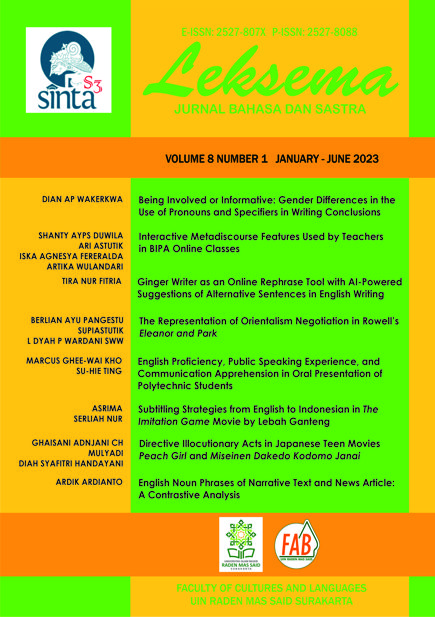GINGER WRITER AS AN ONLINE REPHRASE TOOL WITH AI-POWERED SUGGESTIONS OF ALTERNATIVE SENTENCES IN ENGLISH WRITING
DOI:
https://doi.org/10.22515/ljbs.v8i1.4814Keywords:
English writing, Ginger Writer, online rephrasing tool, paraphrasingAbstract
This is a descriptive-qualitative study analyzes the use of Ginger Writer as an online rephrase tool based on AI-powered suggestions in English writing. The result of analysis shows that the free edition of the Ginger Writer application is used for the implementation. Some techniques of rephrasing applied b the tools are: (1) rephrasing by using equations/synonyms of words. (2) rephrasing by changing/rearranging the sequence of words based on the relevant rules. (3) rephrasing by altering the word's form, (4) rephrasing by using the active or passive form, (5) rephrasing by changing the word class, and (6) rephrasing word into phrase, phrase into clause, and vice versa. Ginger Writer makes writing high-quality work effortless for users. Not only adds missing words, completes fragmented phrases, and corrects spelling problems related to the context of sentences, Ginger Writer also adds missing words, completes fragmented sentences, and corrects spelling errors. This online rephrasing tool is considerably fast but teachers and students should double-check their work. To some extent, manual paraphrasing is considered better and, even the best in quality, compared to the automatic ones.
Downloads
References
Alvi, Faisal, Mark Stevenson, and Paul Clough. 2021. “Paraphrase Type Identification for Plagiarism Detection Using Contexts and Word Embeddings.” International Journal of Educational Technology in Higher Education 18 (1): 1–25. https://doi.org/10.1186/s41239-021-00277-8.
Ansorge, Libor, Klára Ansorgeová, and Mark Sixsmith. 2021. “Plagiarism through Paraphrasing Tools: The Story of One Plagiarized Text.” Publications 9 (4): 48. https://doi.org/10.3390/publications9040048.
Bhagat, Rahul, and Eduard Hovy. 2013. “What Is a Paraphrase?” Computational Linguistics 39 (3): 463–72. https://doi.org/10.1162/COLI_a_00166.
Chen, M.-H., S.-T. Huang, J.s. Chang, and H.-C. Liou. 2015. “Developing a Corpus-Based Paraphrase Tool to Improve EFL Learners’ Writing Skills.” Computer Assisted Language Learning 28 (1): 22–40. https://doi.org/10.1080/09588221.2013.783873.
Fitria, Tira Nur. 2021a. “Implementation of Institution’s E-Learning Platform in Teaching Online at ITB AAS Indonesia.” EDUTEC : Journal of Education And Technology 4 (3): 493–503. https://doi.org/10.29062/edu.v4i3.157.
Fitria, Tira Nur. 2021b. “Grammarly as AI-Powered English Writing Assistant: Students’ Alternative for Writing English.” Metathesis: Journal of English Language, Literature, and Teaching 5 (1): 65–78. https://doi.org/10.31002/metathesis.v5i1.3519.
Fitria, Tira Nur. 2021c. “QuillBot as an Online Tool: Students’ Alternative in Paraphrasing and Rewriting of English Writing.” Englisia: Journal of Language, Education, and Humanities 9 (1): 183–96. https://doi.org/10.22373/ej.v9i1.10233.
Flick, Uwe. 2018. An Introduction to Qualitative Research. SAGE.
Hesse-Biber, Sharlene Nagy. 2016. The Practice of Qualitative Research: Engaging Students in the Research Process. SAGE Publications.
Keck, Casey. 2006. “The Use of Paraphrase in Summary Writing: A Comparison of L1 and L2 Writers.” Journal of Second Language Writing 15 (4): 261–78. https://doi.org/10.1016/j.jslw.2006.09.006.
Kettel, Raymond P., and Danielle L. DeFauw. 2018. “Paraphrase Without Plagiarism: Use RRLC (Read, Reread, List, Compose).” The Reading Teacher 72 (2): 245–55. https://doi.org/10.1002/trtr.1697.
Miles, Matthew B., and A. Michael Huberman. 1994. Qualitative Data Analysis: An Expanded Sourcebook. SAGE Publications.
Miles, Matthew B., A. Michael Huberman, and Johnny Saldana. 2014. Qualitative Data Analysis. SAGE Publications.
Na, Chi Do, Nhat Chi Mai, and Nguyen Xuan. 2017. “Paraphrasing in Academic Writing: A Case Study of Vietnamese Learners of English.” Language Education in Asia 8 (1): 9–24.
Prentice, Felicity M., and Clare E. Kinden. 2018. “Paraphrasing Tools, Language Translation Tools and Plagiarism: An Exploratory Study.” International Journal for Educational Integrity 14 (1): 1–16. https://doi.org/10.1007/s40979-018-0036-7.
Rahmatika, Quin Isnaini. 2017. “YouParaphrase.Com as a Paraphrasing Tool for Spoof Text on a “Readers’ Digest” Magazine.” Unpublished Thesis, University of Muhammadiyah Malang. https://eprints.umm.ac.id/35737/.
Rogerson, Ann M., and Grace McCarthy. 2017. “Using Internet Based Paraphrasing Tools: Original Work, Patchwriting or Facilitated Plagiarism?” International Journal for Educational Integrity 13 (1): 1–15. https://doi.org/10.1007/s40979-016-0013-y.
Sulistyaningrum, Siti Drivoka. 2021. “Utilizing Online Paraphrasing Tools to Overcome Students’ Paraphrasing Difficulties in Literature Reviews.” Journal of English Language Studies 6 (2): 229–43. https://doi.org/10.30870/jels.v6i2.11582.
Downloads
Published
Issue
Section
License
Copyright (c) 2023 Leksema: Jurnal Bahasa dan Sastra

This work is licensed under a Creative Commons Attribution-NonCommercial-ShareAlike 4.0 International License.
The copyright of the received article shall be assigned to the publisher of the journal. The intended copyright includes the right to publish the article in various forms (including reprints). The journal maintains the publishing rights to published articles.
In line with the license, the authors and users (readers or other researchers) are allowed to share and adapt the material only for non-commercial purposes. In addition, the material must be given appropriate credit, provided with a link to the license, and indicated if changes were made. If authors remix, transform or build upon the material, authors must distribute their contributions under the same license as the original.







